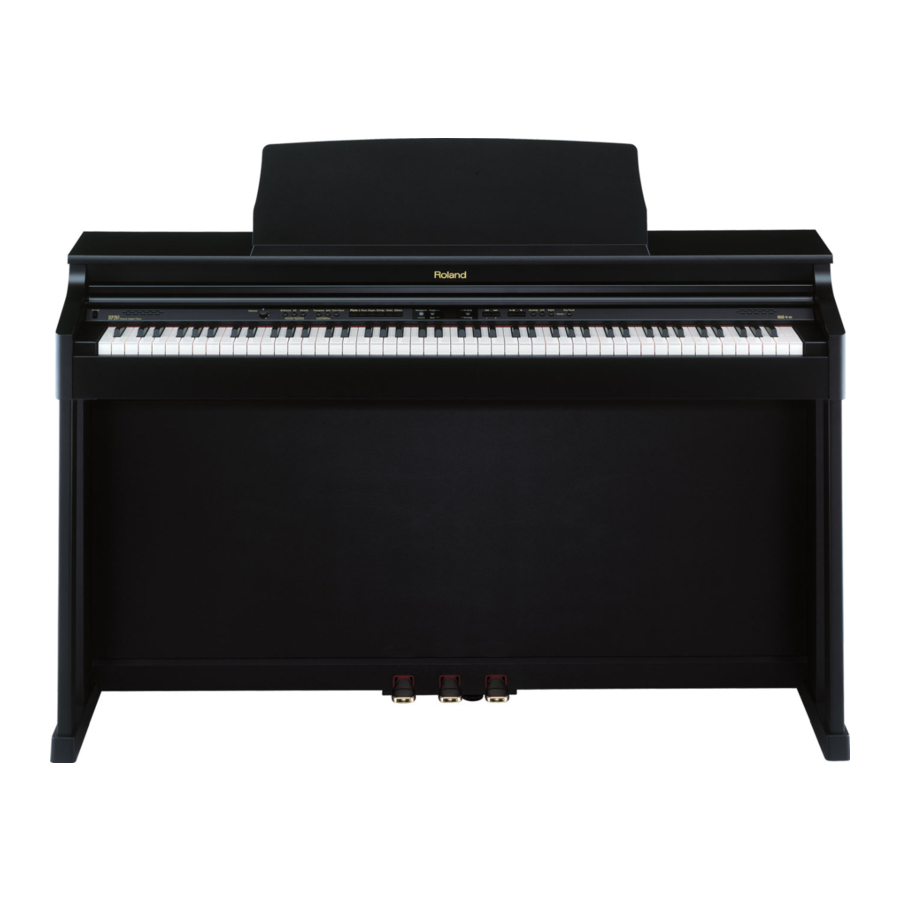
Table of Contents
Advertisement
Quick Links
Exploring the HP-203
Roland Corporation US
1.
IT'S A PIANO by 'default' (every time you turn it on).
a. Touch
i. Modeled from grand piano (not vertical)
ii. Gravity based system with NO springs
iii. Progressively weighted (as a fine, well-regulated grand)
b. Tone – from the world's most widely used concert grand
c. Importance of adjusting:
i. Volume control (LEFT on Panel) [OM page 18]
ii. Brilliance control (LEFT on Panel) [OM page 18]
2. INCREDIBLY USEFUL FEATURES
a. No tuning maintenance required offers two outstanding benefits:
i. It's ALWAYS in tune.
ii. It requires NO periodic maintenance. (NO maintenance cost)
b. Transposition – You play a piece in any key, and hear it any key you select
c. Transpose button is on the LEFT end of the panel. [OM page 30]
3. CHOOSING TONES (voices, sounds) [OM page 25]
a. The importance of exploring the tonal resources
b. Push a tone group button (located just to LEFT of the display).
c. You may use the -/+ buttons to the RIGHT of the display to 'scroll' through the sounds.
Each tone is identified by a number, the display shows the number of the currently
selected tone.
d. A complete list of tones begins on page 88 of the owner's manual.
e. For those interested, Drum 'MAPS' begin on page 92 of the owner's manual.
4. TWIN PIANO MODE – This exciting preset mode allows you to divide the keyboard into left and
right keyboards, each with middle 'C' in the center. This allows two students to work
simultaneously at one piano. [OM page 31]
a. To activate TWIN PIANO MODE, simply touch the TWIN PIANO button.
b. The grand piano sound is assigned to both the left and right areas of the keyboard.
c. The right pedal is the damper pedal for the right keyboard, and the left pedal is the
damper for the left keyboard.
d. You can change the way the TWIN PIANO sound is heard by holding the TWIN PIANO
button and while holding the button down use the -/+ buttons to choose in the display:
i. 1. The sound 'pans' normally from left to right and would be used if the
instrument is being played through its internal speakers.
ii. 2. Notes played on the left area of the keyboard are only heard from the left
speaker, and notes on the right . . . only from the right speaker. This is the mode
to choose (#2) when using TWIN PIANO mode with the RCS848 classroom
controller.
Roland Corporation US
Contemporary Keyboard Division
page 1
Exploring the HP-203
Advertisement
Table of Contents

Summary of Contents for Roland HP-203
- Page 1 Exploring the HP-203 Roland Corporation US IT’S A PIANO by ‘default’ (every time you turn it on). a. Touch i. Modeled from grand piano (not vertical) ii. Gravity based system with NO springs iii. Progressively weighted (as a fine, well-regulated grand) b.
- Page 2 Now touch the TWIN PIANO button. The display will indicate “dPr”. (If the display does not indicate “dPr”, hold down the TWIN PIANO button and while holding it down use the -/+ buttons to change the display until it does indicate “dPr”) Roland Corporation US page 2 Exploring the HP-203...
- Page 3 To adjust the beat use the -/+ buttons. d. To change the metronome VOLUME, hold the Metronome button down and while continuing to hold the metronome button down use the -/+ to adjust the volume. Roland Corporation US page 3 Exploring the HP-203...
- Page 4 RIGHT track part, you might now touch the LEFT TRACK button to record to that track.) ix. Begin playing the next part . . . the HP-203 will begin playback of your first part as soon as you touch a key.
- Page 5 STOP/PLAY and RECORD buttons will blink. k. To complete the process and save the song, press the RECORD button. If you have decided to NOT save the song, press PLAY/STOP to CANCEL. Roland Corporation US page 5 Exploring the HP-203...
- Page 6 From an EXTERNAL CD DRIVE (Audio CDs, or CDs containing MIDI files) g. The HP-203 can read and play standard MIDI files of both Type O and Type 1. 15. PLAYING SONG FILES (SMF or AUDIO (WAV) files)[OM page 40] a.
- Page 7 17. Other FUN things to know . . . a. When you record on the HP-203 and save the song file to disk it is saved as a Standard MIDI File (SMF – type 0) which can be opened in all popular notation and/or sequencing programs (Finale, Sibelius, etc.) Make certain when you open the file in the computer...












Need help?
Do you have a question about the HP-203 and is the answer not in the manual?
Questions and answers